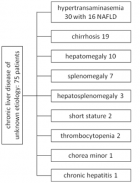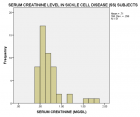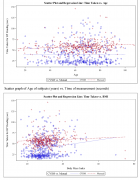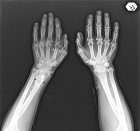About Sapienza University of Rome
Sapienza University of Rome
Articles by Sapienza University of Rome
Incidental findings in traditional nuclear medicine practice
Published on: 28th July, 2018
OCLC Number/Unique Identifier: 7802611730
The presence of an incidental finding, defined as an abnormality which is unrelated to the initial scanning indication, is widely increases due to the access to new devices and imaging modalities. This growing number of incidental findings can lead to additional medical care including unnecessary tests nevertheless, in a minority of patients, can lead to diagnosis of an important and unexpected condition that could be crucial for the patient. We reported three cases in which nuclear medicine imaging, performed for different reasons and showed a relevant and unexpected pathology. In the case 1, a bone scan, performed in a 66 aged woman for breast cancer staging, allowed the diagnosis of a uterine fibroma. In the case 2, a HMPAO labeled-WBC scintigraphy performed because of a suspect of osteomyelitis, showed a remarkable heart-shaped photopenic area, highly suggestive of cardiac global dilatation. In the case 3, a 62 aged man referred to bone scintigraphy for the staging of recent diagnosed lung cancer. The bone scan allowed the diagnosis of a meningioma. Therefore, the occurrence of incidental findings could lead to reveal relevant abnormalities for the diagnostic pathway.
Fluticasone furoate/Vilanterol 92/22 μg once-a-day vs Beclomethasone dipropionate/Formoterol 100/6 μg b.i.d. in asthma patients: a 12-week pilot study
Published on: 27th September, 2017
OCLC Number/Unique Identifier: 7317597138
Two of the most recent LABA/ICS combinations for treatment of persistent asthma are Fluticasone furoate/Vilanterol 92/22 µg (Ellipta) and Beclomethasone dipropionate/Formoterol 100/6 µg (Nexthaler).
Objective: To compare once-daily Fluticasone/ Vilanterol combination with twice daily Beclomethasone/ Formoterol association in moderate asthma, in terms of quality of life and lung function.
Methods: Fourty patients with moderate asthma treated with Beclomethasone/Formoterol 100/6 µg or Fluticasone/Vilanterol 92/22 µg. We revalued patients in terms of lung function and Asthma Control Test, at 4, 8 and 12 weeks to assess any differences between the two groups. After 4 weeks, thirty-one of the fourty patients were evaluated in terms of respiratory function at predetermined time intervals.
Result: In patients treated with beclomethasone/formoterol FEV1 presented a mean value of 78% at the third visit and of 79.1% during the final check, compared with 74.5% and to 75.8% in patients in treatment with fluticasone/vilanterol (p 0.01). Mean values of IC and MMEF25-75% were higher in patients treated with beclomethasone/formoterol compared with fluticasone/vilanterol. For the dyspnea it was a difference at the third observation. For the nocturnal symptoms and the use of rescue drug there was a significant difference, except at the beginning. For the perception of control by patients, there was a difference in the two groups at the beginning, after 4 and 8 weeks. Total ACT score showed a significant difference after 4, 8 and 12 weeks. In the group treated with beclomethasone/formoterol FEV1 value was significantly higher at a distance of four hours after drug administration (p 0.04) and after the second dose (p 0.02) compared with the group treated with fluticasone/vilanterol.
Discussion: Patients in treatment with beclomethasone/formoterol showed improved asthma control and nocturnal symptoms and more stable respiratory function compared with patients receiving fluticasone/vilanterol.
Facing biological risk in child and adolescence neuropsychiatric services during COVID-19 outbreak: Management of protection levels for the direct access
Published on: 29th December, 2020
OCLC Number/Unique Identifier: 8876014608
COVID-19 emergency requests a new definition of security procedures adopted in Child and Adolescence Neuropsychiatric Services (CANS).
The WHO recommends using Personal Protective Equipment (PPE) for preventing inter-human transmission of viral diseases [1]. These recommendations regard primarily hospitalized patients and ambulatory medical services for adults.
Influence of corneal spherical aberration, anterior chamber depth, and ocular axial length on the visual outcome with an extended depth of focus wavefront-designed intraocular lens
Published on: 8th August, 2022
Purpose: The purpose of the study was to evaluate which ocular parameters have an impact on visual results obtained after an extended depth of focus (EDF) wavefront-designed intraocular lens (IOL). Setting: The study was conducted in three Italian centers (private practice in Lucca and two ambulatory surgical centers in Pisa and in Rome) from 01/09/2014 to 30/09/2015.Design: The study population included 178 eyes of 91 patients who had cataract surgery and implantation of an EDF wavefront - designed IOL (Mini Well Ready - SIFI Med Tech S.r.l.).Methods: Preoperative and postoperative refractive corneal spherical aberration (SA), ocular axial length, or anterior chamber depth were measured.Results: The majority of patients were spectacle-independent for near, intermediate, and distance vision and no one reported disturbing halos or glare. No overall significant differences were observed when stratifying anterior chamber depth (ACD) and ocular axial length (AL) by uncorrected distance visual acuity (UCDVA); p = 0.465 and 1.000 respectively, corrected distance visual acuity (CDVA); p = uncorrected near visual acuity (UCNVA); p = 1.000 and 0.728 respectively; p = 1.000 under both parameters and halos; 1.000 under both parameters. Still, there was a statistically significant difference when stratifying SA with 5 mm only by UDVA (p = 0.040).Conclusion: These results are consistent with similar outcomes in the scientific literature as measured with tests of visual acuity, either with or without optical correction. We also demonstrated that these IOLs can be used in myopic and hyperopic eyes, although it may be useful to evaluate the preoperative corneal SA to achieve better results.

HSPI: We're glad you're here. Please click "create a new Query" if you are a new visitor to our website and need further information from us.
If you are already a member of our network and need to keep track of any developments regarding a question you have already submitted, click "take me to my Query."
























































































































































